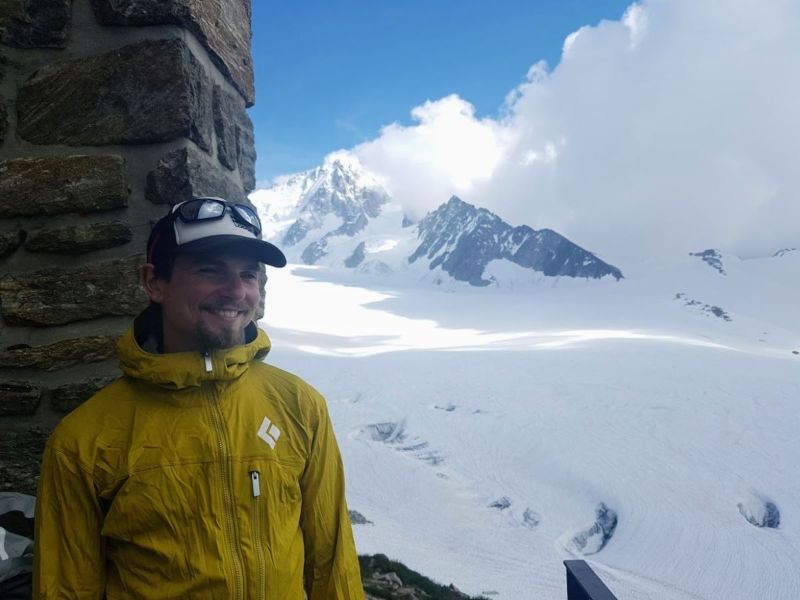Mountain guide
"The best part of my work is variability, as hiking destinations and outdoor activities vary depending on the season. I feel privileged to spend a lot of time in nature and work with people."

- Fredrik Aspö
- As a mountain guide and ski instructor in their own company, Attmankan Ab.
- Has graduated as a wilderness guide from Axxell Utbildning, as well as completed the International Federation of Mountain Guides Associations IFMGA mountain guide training of the Swedish Mountain Guide Association (SBO).
- 10 years of work experience in the field.
Briefly explain what you do for a living.
I work as a mountain guide and ski instructor mainly in Northern Norway. My tasks vary depending on the season. In January and February, my customers want guidance on freeriding, and I also hold snow safety courses. As the spring progresses, I instruct more ski trips. The busiest skiing season is from March to mid-May.
In the summer, I guide climbing and glacier excursions in the Alps. Glacier excursions continue until the end of September, after which there is time to rest before the next season. In December, I organise ice climbing courses and guided tours in Northern Norway.
How have you ended up in the profession of your choice?
When I was young, I was interested in hiking and especially climbing. After the military, I met Petter Reuter, Finland's first mountain guide. That's when I realized I could do this for a living.
As certain access requirements have been set for the mountain guide training, I determinedly gathered experience of climbing and freeriding for five years. I was admitted to the training, and after four years of studies, I graduated as a mountain guide.
Describe your typical working day or week.
On a typical working day during the skiing season, I organise a day trip to the mountains. In the morning, I meet the customers and hold a short briefing about the weather and snow conditions of the day. At the same time, I listen to the group’s wishes and assess the condition and goals of the skiers. After that, we jointly select a suitable route option for the group.
After the briefing, we move to the starting point and start skiing towards the mountains. The climb to the mountains usually takes from 3 to 5 hours, and along the way we take a lunch break in beautiful landscapes. At the top, we remove the skins from the skis and ski back down to the starting point. At the end of the day, I collect feedback on the excursion during the joint after ski.
What kind of work environment or working hours do you have?
I work outside at the mercy of nature. There are many hazards associated with my work environment, such as avalanches and glacier crevasses. Even small injuries can quickly become dangerous due to cold weather, for example, as the risk of hypothermia increases.
My working hours vary, but I strive to ensure that my working days do not exceed eight hours. If customers want a longer trip, I have to charge more for it. I need time for recovery and preparation, and I cannot go on a new excursion the following day after a long day.
The work involves a lot of travel. I’m usually on holiday from mid-May to Midsummer and from October to November.
What kind of competence or qualities are required in the profession?
Mountain guides must have excellent alpine skiing and climbing skills, as well as command of rope techniques. It is important to consider safety in all situations and prepare carefully for the excursions, so that they can be implemented as risk-free as possible.
Interaction skills are also important, as this is a customer service profession. One of the most important skills of the guide is the ability to read people, i.e. to assess the physical fitness of customers, their current condition, wishes, and goals. At the same time, they must consider the entire group so that each participant gets a good experience of the excursion.
What is the best thing about your profession?
The best part of my work is variability, as hiking destinations and outdoor activities vary depending on the season. I feel privileged to spend a lot of time in nature and work with people.
What are the downsides of the profession or what seems challenging?
Every time a climbing or freeriding enthusiast has a serious accident in the area where I work, it shocks me. Fortunately, they rarely occur, and having an experienced guide significantly reduces the risks. The busy skiing season is also often both mentally and physically stressful.
What would you tell a person considering the profession of a mountain guide?
Many people dream of becoming a mountain guide, but only those who have a long-term and persistent approach will progress to the training and working life. An interest in climbing or skiing alone is not enough; you must be willing to teach and work with people.
You cannot train as a mountain guide in Finland, and the job opportunities are very limited. Training is organised, for example, in Sweden and Norway.
How do you see the future of your profession?
There will be plenty of work for mountain guides in the future. Interest in guide services is growing, especially in Northern Norway, as the area has a relatively cool climate and safe conditions. On the other hand, global warming makes it more difficult to work, for example, in the Alps, due to rocks and ice fall avalanches.
The use of technology is increasing in people’s everyday lives, so many people need nature experiences as a counterbalance. It is increasingly visible in customer numbers.
